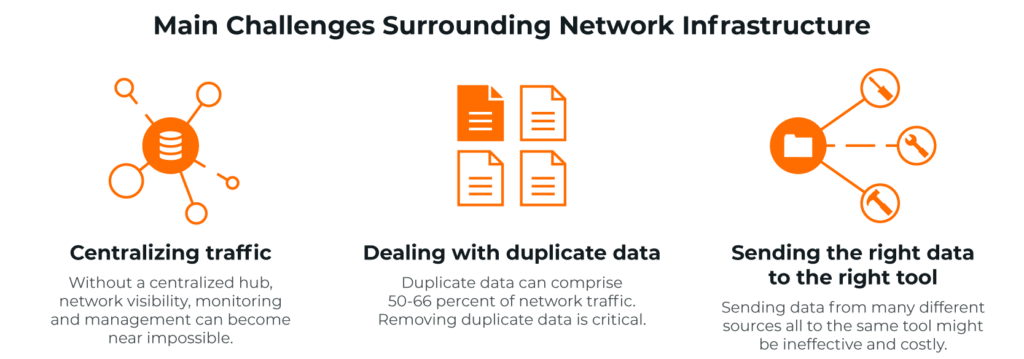What Is Network Infrastructure?
Network infrastructure refers to all of the resources of a network that make network or internet connectivity, management, business operations, and communication possible.
Network infrastructure comprises hardware and software, systems and devices, and it enables computing and communication between users, services, applications, and processes. Anything involved in the network, from servers to wireless routers, comes together to make up a system’s network infrastructure. Network infrastructure allows for effective communication and service between users, applications, services, devices, and so forth.
The Importance of Network Infrastructure
Your network is at the heart of your business. But for it to function correctly, it needs the right support — in the form of effective network infrastructure. Now that we know what network infrastructure is, how can you ensure that you’re getting the most out of it?
In this digital age, an organization’s agility and productivity depend on more than just hardworking employees and excellent equipment. Running a smooth operation also requires a robust, clean, and secure network infrastructure. Without the right network infrastructure in place, you may suffer from poor user experience and security issues that can impact employee productivity, cost you money, and damage your brand.
As such, business executives must understand the importance of network infrastructure and be aware of the challenges and opportunities it presents. With this knowledge and the right tools in place, you are taking the first steps to ensure optimum productivity and help your organization maintain peak levels of performance.
Common Key Components of a Network Infrastructure
A robust network infrastructure comprises a mix of hardware devices, software applications, and network services, each playing a critical role in ensuring seamless connectivity and efficient operation:
Networking Hardware Devices:
- Routers, switches, hubs, repeaters, gateways, bridges, network interface cards (NICs), cables and connectors, firewalls, and modems form the physical backbone of the network infrastructure, facilitating data transmission between IT resources.
Software Network Resources:
- Integrating physical network infrastructure with software applications and services can lead to slower deployment speeds. Software-defined networking offers flexibility and control, enabling the creation of virtual networks and the implementation of policies for workload isolation.
Monitoring and Management Tools:
- These tools are indispensable for maintaining network health and security, providing real-time insights into network performance and enabling proactive troubleshooting to address issues such as latency spikes, dropped packets, and anomalous traffic that may indicate malicious activity. Leveraging advanced monitoring and management solutions ensures that organizations can effectively manage their network infrastructure, optimize performance, and swiftly respond to emerging challenges, thereby enhancing overall operational efficiency and minimizing downtime.
Network Services:
- Encompass fundamental protocols such as TCP, UDP, and IP addressing, facilitating seamless communication between devices and applications within your network infrastructure.
Hybrid Infrastructures:
- Organizations can extend their network capabilities by integrating third-party services from managed service providers (MSPs) or establishing hybrid infrastructures combining on-premises setups with cloud services.
This comprehensive approach to network infrastructure ensures that businesses can adapt to evolving technological landscapes while maintaining the reliability, security, and scalability necessary for success in today’s digital world.
What Are the Main Challenges Surrounding Network Infrastructure?
There are several challenges involved with running a network infrastructure model. Some of the top network infrastructure challenges are:
- Centralizing traffic
- Dealing with duplicate data
- Sending the right data to the right tool
1. Centralizing Traffic
Within an organization, there are often multiple different subnets and locations or sites. Without a centralized hub, network visibility, monitoring, and management can become near impossible. Many companies use network infrastructure solutions to centralize traffic to better understand and monitor the data traversing their networks. This enhances their security posture and helps network operations teams address performance issues.
2. Dealing with Duplicate Data
In some cases, duplicate data can comprise 50 to 66 percent of network traffic. Removing duplicate data is critical, particularly when it comes to the effectiveness of network security solutions. If the security solutions get too much duplicate data, they may be slowed down and less effective in detecting threats.
3. Sending the Right Data to the Right Tool
Many organizations use several different cybersecurity tools and providers. Many security providers often charge based on how much data they need to process. As such, sending the right type of data to the right tool is a critical aspect of infrastructure networking. Sending data from many different sources all to the same tool might be ineffective and costly, particularly if one tool is best suited to one type of data and another tool to another type.
How Does Gigamon Help?
Keeping a clean and efficient network infrastructure is no small feat. That’s why it’s helpful to have a company with deep networking and security expertise on your side. Network infrastructures simply aren’t as cut and dried as they used to be; they are now often a mix of on-premises and cloud, including network infrastructure services. And even within on-premises networking, there tends to be a mishmash of different types of networks and vendors.
Inorganic growth and mergers and acquisitions can further muddle the network infrastructure. The result is that companies can end up with five separate tools that all monitor and manage one large hybrid network. For companies that want to keep their network safe and operating at peak performance, this is not ideal. Establishing one centralized hub for network visibility is critical and so is the ability to direct the right traffic to the right tools. That’s where Gigamon comes in.
The Importance of Network Visibility
Maintaining full visibility across your whole network infrastructure is key for both performance monitoring and threat detection. Dealing with network blind spots is a major pain point for many organizations. Gaining broad network visibility enables you to uncover those blind spots, so threats from all sources can be identified and remediated more quickly. Gigamon has the tools and capabilities you need to establish a robust network security infrastructure.
Streamlining the Data Going to Your Tools
Gigamon can help you greatly improve the efficiency of your network and security tools by removing duplicate data usually sent to these tools. Gigamon also enables intelligent traffic filtering so that only the appropriate traffic is sent to the right tools. For example, email traffic is sent to email security tools, but video traffic is not.
With Gigamon, you can free up expensive storage and processing resources used to handle redundant or irrelevant data. Therefore, you can delay future investments and/or leverage existing tools to cover more of your network. Cleaning up your network and making sure it’s strong and secure is an important endeavor. Get the right tools and solutions on your side and you’ll build a strong base that will keep your network running smoothly for years to come.
Further Reading
Featured Webinars
Hear from our experts on the latest trends and best practices to optimize your network visibility and analysis.

CONTINUE THE DISCUSSION
People are talking about this in the Gigamon Community’s Networking group.
Share your thoughts today








 Dan Daniels
Dan Daniels



